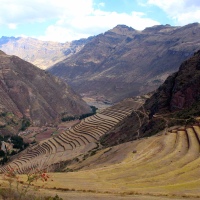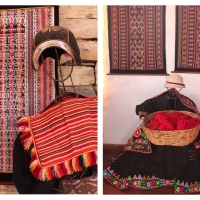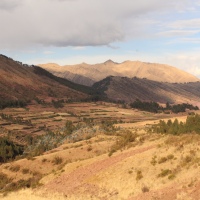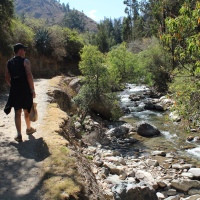Today is Sunday and our last day in San Rafael with our extended WOOFing family. To celebrate, we hosted a fiesta yesterday, which featured over ten litres of wine, one chicken, one goat and a lot of sunshine.
After learning about the Patagonian style of cooking lamb I (Mark) set myself the goal of learning how to cook one while we were living in San Rafael. The farewell fiesta was the perfect excuse! As we have mentioned, chivo (goat) is the popular meat in Mendoza. So, since I couldn't buy lamb, this was the best choice.
We went on a bit of search in the city to find a butcher (carniceria) that could sell us a whole goat. As it turns out this was harder than we thought. The goats are bred in Malargüe, which is two hours drive away, so not everyone stocks it. But we did find two cheerful geezers who were only too happy to sell me 9.7 kgs of frozen chivo.
The process for cooking a goat in the Patagonian style takes about 7 hours, depending on the climate, the size of the carcass and the amount of wood you have. I started at 8 am in the morning. Managed to get the fire going before preparing the framework that would hold up the carcass.
Once that was ready it was carried outside and planted in a hole 40 cm deep and around 1 metre from the fire.
The idea is that you drag hot coals close to the meat to slow cook it. If the day is cold or there's wind etc you can control the heat by adding more coals or shifting the fire closer.
Every couple of hours the whole carcass is basted with saltwater, about a litre in total. It is also important to rotate it on its axis to prevent the meat from getting too hot (remember that the idea is to slow cook it!) and ensure the meat is cooked evenly.
After five hours we added a chicken to the parilla. We bought a whole chicken, which was butterflied and seasoned with paprika, chilli, salt and pepper a day in advance. You can also add vegetables and/or sausages, but we cooked our vegies seperately.

Racking in more coals. Chicken on the right. The grill is raised on bricks with hot embers underneath.
At 2:30 the meat was good to go! Took great joy in carving the meat straight off the frame. Good fun.
The meal was a huge success, everyone was happy, plenty of food and wine to go round and some beautiful sunshine to keep us warm.
¡Salud!
































